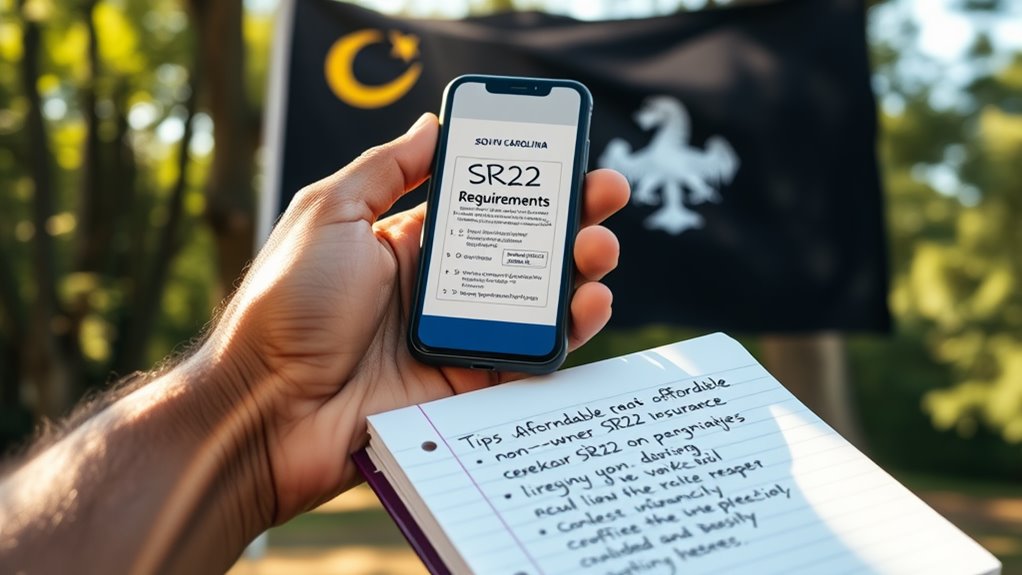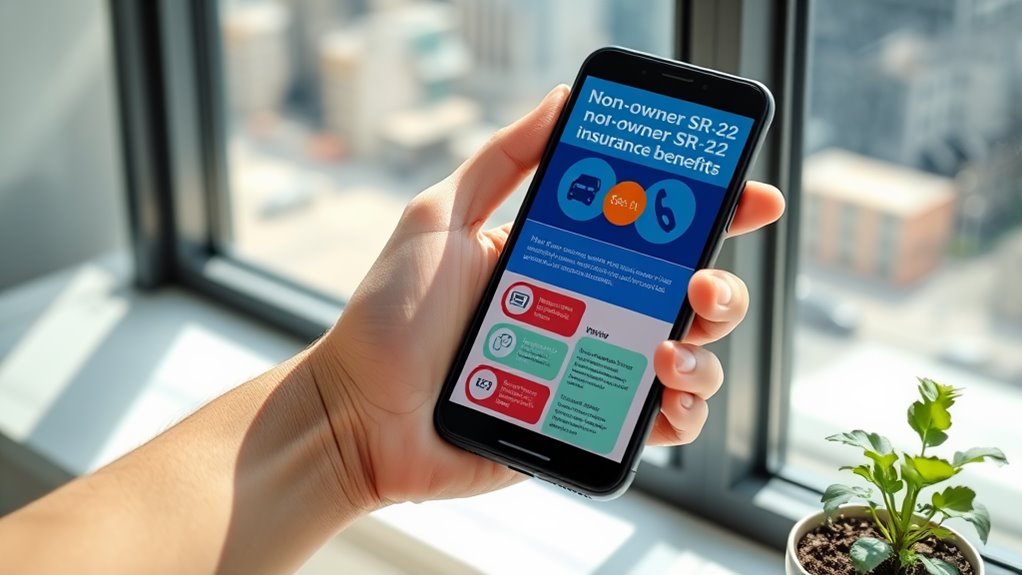Steering through the world of non-owner SR-22 insurance can feel like walking a tightrope, balancing affordability and compliance. You might be wondering how to secure the best rates while meeting state requirements. The good news is, there are practical strategies that can help you save money without sacrificing coverage. Let's explore some essential tips that can make this process smoother and more budget-friendly.
Key Takeaways
- Compare Multiple Quotes: Gather estimates from various insurers online, as rates can differ significantly for non-owner SR-22 insurance.
- Look for Discounts: Inquire about available discounts, such as bundling with other policies or occupational discounts.
- Maintain a Clean Driving Record: Avoid traffic violations and maintain a clean driving history to potentially lower premium rates.
- Pay Annually: Consider paying the premium annually instead of monthly to save on overall costs and avoid installment fees.
- Consult Local Brokers: Work with local insurance brokers who can provide personalized advice and explore regional options for better rates.
Understand SR-22 Requirements in South Carolina

When you find yourself needing SR-22 insurance in South Carolina, it's essential to grasp the requirements involved. This certificate proves you have the minimum auto insurance, a must for serious offenses like DUIs or reckless driving. You'll need to maintain this coverage for at least three years. high-risk drivers typically need an SR-22, which may lead to higher insurance premiums. Expect filing fees between $25 and $50, and be aware of the minimum insurance requirements: $25,000 bodily injury liability per person, $50,000 per accident, and $25,000 property damage liability per accident. Additionally, failure to meet these SR-22 requirements can result in the suspension of your driver's license and vehicle registration. If you don't comply, your driver's license and vehicle registration could be suspended. Understanding these essentials helps you navigate the process and maintain your legal driving privileges without unnecessary complications.
Compare Quotes From Multiple Insurance Providers
Steering through the SR-22 insurance landscape can be overwhelming, but comparing quotes from multiple insurance providers simplifies the process.
Start by using online platforms to gather estimates from various insurers. Each provider has different rates and coverage levels, so you might discover significant cost differences—sometimes over $100 a month.
Don't just focus on price; evaluate customer service and claims handling too. Local insurance brokers can offer a broader selection of policies and insights into regional options that may be cheaper.
Check the financial stability of potential providers through ratings from AM Best or Fitch.
Look for Discounts and Bundling Options
Finding ways to save on your non-owner SR-22 insurance can make a significant difference in your overall costs.
Start by exploring bundling discounts; many insurers offer savings when you combine your non-owner policy with other types like home or renters insurance.
Don't overlook occupational discounts, as certain professions may qualify for reduced rates.
If you can, consider paying your premium annually instead of monthly for additional savings.
While less common, good student discounts might also apply if you're a younger driver.
Finally, take the time to ask about available discounts when getting quotes—every little bit helps in making your insurance more affordable!
Maintain a Clean Driving Record

Keeping your non-owner SR-22 insurance costs manageable starts with maintaining a clean driving record. Avoiding serious infractions like DUIs or multiple traffic offenses is vital, as these often trigger SR-22 requirements.
A clean record not only lowers your insurance premiums but also strengthens your negotiating position when seeking quotes. Responsible driving practices, such as obeying traffic laws and avoiding speeding, help prevent violations that could lead to higher costs and the need for SR-22 filings.
Consider Defensive Driving Courses
If you're looking to lower your non-owner SR-22 insurance costs, considering defensive driving courses can be a smart move.
These courses provide valuable knowledge on safe driving practices and equip you with techniques to handle challenging situations. By improving your awareness of potential hazards and understanding traffic laws, you'll become a more competent driver.
Many insurance companies offer discounts for completing these courses, which can greatly lower your premiums. Additionally, demonstrating your commitment to safety can mitigate the risk perceived by insurers, helping you avoid future infractions.
With various online and offline options available, you can easily find a course that fits your schedule. Ultimately, this investment in your driving skills can lead to substantial savings over time.
Raise Your Deductibles Wisely
Improving your driving skills through defensive driving courses can set a solid foundation for better insurance options.
One effective strategy to reduce your SR-22 insurance premiums is to raise your deductibles. Higher deductibles usually translate to lower monthly costs, but it's crucial to assess your financial situation first. Make sure you can cover the deductible amount in case of an accident.
Use online comparison tools to explore various providers, as they often offer different deductible levels. Remember, while higher deductibles can save you money, frequent claims can negate those savings.
Always verify your deductible adjustments comply with state requirements and consider consulting an insurance broker for tailored advice. Balancing risks and savings is key to making the right choice.
Explore Non-Owner SR-22 Insurance Benefits

While you might think auto insurance is only for vehicle owners, non-owner SR-22 insurance offers a range of benefits that can be a game-changer for those who frequently drive borrowed or rental vehicles.
Here are some key advantages:
- Affordable Coverage: Generally cheaper than standard auto insurance since it doesn't cover vehicle damage.
- Legal Compliance: Meets state insurance requirements and court orders, aiding in license reinstatement.
- Liability Protection: Covers accidents while driving borrowed or rental cars.
- Flexibility: Lets you drive different vehicles without needing to list them on a policy.
With these benefits, non-owner SR-22 insurance can provide essential protection and help you stay compliant, making it a smart choice for many drivers.
Be Aware of State-Specific Regulations
Understanding the intricacies of state-specific regulations is essential when managing non-owner SR-22 insurance. Each state has unique requirements regarding the SR-22 filing, including coverage levels and duration.
For serious traffic offenses, like DUIs or reckless driving, you may need this certification to prove financial responsibility. Be aware that some states require an FR-44, which mandates higher liability coverage.
Additionally, your filing period could range from one to five years, depending on your state and violation. If you relocate, make sure you comply with your new state's rules, as non-compliance could lead to license suspension and fines.
Familiarizing yourself with these regulations can save you from unpleasant surprises down the road.
Communicate Regularly With Your Insurance Provider
Once you've grasped the state-specific regulations for non-owner SR-22 insurance, it's time to focus on maintaining a good relationship with your insurance provider.
Regular communication is key to ensuring you meet compliance and get the best rates. Here are some tips to keep in mind:
- Discuss policy customization to fit your specific needs.
- Ask about cost-effective options to negotiate better prices.
- Update your insurer about any changes in your driving or employment status.
- Manage payments by setting up automatic methods to avoid late fees.
Monitor Policy Updates and Cancellations
To keep your non-owner SR-22 insurance effective, it's essential to actively monitor policy updates and potential cancellations.
States have varying liability coverage requirements, which can impact your premiums. If you fail to maintain continuous coverage, you may have to re-file the SR-22, extending your mandatory coverage period.
States have different liability coverage requirements, affecting premiums and potentially leading to extended SR-22 coverage if continuous insurance is not maintained.
Regularly check in with your insurer to confirm compliance and verify your SR-22 filing is up-to-date. Promptly pay your premiums to avoid late fees or policy cancellations, which could jeopardize your driving privileges.
Consider setting up automatic payments for timely transactions. Finally, be aware of your state's rules on grace periods to prevent unexpected lapses in coverage that could complicate your SR-22 status.
Stay proactive to maintain your insurance effectively.
Conclusion
Maneuvering the world of non-owner SR-22 insurance can feel overwhelming, but with the right approach, it doesn't have to break the bank. By comparing quotes and hunting for discounts, you can save considerably. While maintaining a clean driving record is essential, remember that ongoing communication with your insurer keeps you informed and protected. Balancing these strategies guarantees you're covered without sacrificing your budget—turning what could be a financial burden into an opportunity for savings and peace of mind.
